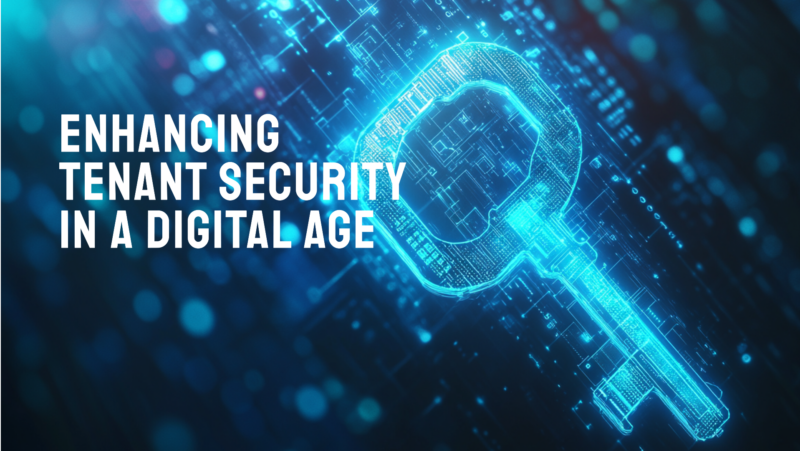
As commercial properties continue to embrace digital transformation, the nature of security is rapidly changing. No longer is security limited to physical barriers like locks, alarms, or guards—today’s commercial buildings are interconnected systems where cybersecurity is just as vital as physical safety. The rise of IoT devices, cloud-based management platforms, and digital tenant services have introduced new vulnerabilities that building operators must address.
In this edition, we will explore how modern security systems must evolve to protect both the physical and digital aspects of properties, ensuring tenant safety in a highly connected world. From smart security systems to robust cybersecurity protocols, the integration of technology has made an intentional and comprehensive security approach essential for safeguarding tenants, their data, and the property itself.
The Importance of Cybersecurity for Modern Properties
As commercial properties integrate more IoT devices, cloud-based systems, and digital platforms, the risk of cyberattacks increases significantly. Every connected device or system—whether it’s a smart thermostat, surveillance camera, or tenant management platform—presents a potential vulnerability that can be exploited if not properly secured. Hackers can target building management systems to gain unauthorized access or disrupt operations, which could compromise tenant safety and privacy. To explore how commercial real estate is adapting to these evolving security challenges, read Cybersecurity: Fortifying Commercial Real Estate for a Digital World.
Ensuring the protection of tenant data is now as critical as securing the physical building. Sensitive information, from tenant credentials to building access codes, must be safeguarded to maintain trust and avoid costly breaches.
“Cybersecurity in modern properties is no longer optional; it is essential to protect both tenants and the systems that run the building.”
By implementing comprehensive cybersecurity measures, building operators can reduce the risk of attacks and ensure their properties are not only physically secure but digitally protected as well. A robust cybersecurity strategy enhances tenant trust and secures the long-term operational success of the building.
Leading with Innovation: Harnessing Technology in Commercial Real Estate | Layer 10
Smart Security Systems: Protecting Tenants and Buildings
The rise of smart security systems in commercial properties has transformed how buildings are monitored and secured. Technologies such as access control, facial recognition, and real-time intelligent surveillance offer advanced safety measures that surpass traditional security methods. These systems allow for greater precision, automatically identifying potential threats and granting or restricting access based on preset criteria. To see how smart technologies are also transforming residential settings, check out this article on Smart Home Technology in Apartment Living.
For example, access control systems can use biometric data or mobile devices to provide secure, keyless entry, while intelligent surveillance offers live monitoring and immediate alerts in case of suspicious activity. Modern systems are equipped with AI to identify suspicious behavior such as unseasonable attire and aggressive gaits to alert staff to threats before they happen.
“Smart security systems enhance safety by automating monitoring processes and significantly improving response times in emergencies.”
These technologies ensure that building operators can act quickly, keeping both tenants and the property safe. By automating monitoring and integrating real-time alerts, smart security systems provide a proactive approach to safeguarding modern properties.
The Role of PropTech in Redefining Tenant Experience | Layer 10
Integrating Cybersecurity with Physical Security
In today’s digital landscape, the need to integrate cybersecurity with physical security is growing rapidly. Modern buildings rely on interconnected systems where the lines between physical safety and digital protection are increasingly blurred. A comprehensive security approach ensures that both cyber and physical threats are addressed simultaneously, preventing unauthorized access to sensitive areas and protecting building management systems from cyberattacks. For insight into how AI is shaping cybersecurity, read more in this article on Cybersecurity and AI: The Challenges and Opportunities.
A breach in a building’s network, for example, could allow unauthorized individuals to manipulate access control systems, leading to physical security threats.
“An integrated approach protects both the infrastructure and the people within it, ensuring all vulnerabilities are covered.”
By combining digital and physical security measures, commercial properties can safeguard both tenants and the systems that run the building, creating a more secure environment.
Conclusion: Future-Proofing Properties with Smarter Security Solutions
Investing in both physical and cyber security solutions is essential for future-proofing commercial properties. As buildings become more interconnected through digital systems, the risk of both physical and cyber threats increases. Implementing integrated security measures ensures tenant trust, protects sensitive data, and enhances the overall safety of the property.
By combining advanced smart technologies with strong cybersecurity protocols, building operators can safeguard their properties from evolving threats, ensuring long-term operational success and maintaining a competitive edge in the market.
Is your commercial property equipped with the latest intelligent security and cybersecurity solutions? Protect your tenants, data, and building infrastructure by integrating advanced security measures.
Layer 10 is here to help you future-proof your property with cutting-edge technology that ensures safety and long-term success. Contact us today to learn more about enhancing both physical and digital security for your space.
Let’s build tomorrow, today.